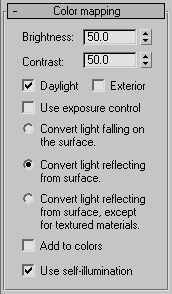The LS Colors modifier converts Lightscape radiosity values to 3ds Max vertex colors.
When you import a Lightscape model into 3ds Max, the radiosity values are kept as irradiances; that is, they describe the intensity of light falling on a mesh in physical units. This modifier converts the physical units to RGB colors. In conjunction with the Lightscape Mesh modifier, this modifier can be used to produce meshes suitable for game engines.

Turn on for exterior daylight simulations. Default=off.
When on, disregards the settings of Brightness, Contrast, Daylight, and Exterior, and instead uses the settings of the active exposure control. If no exposure control is active in the scene, this toggle is disabled. Default=off.
The three radio buttons that follow choose how to handle irradiance values.